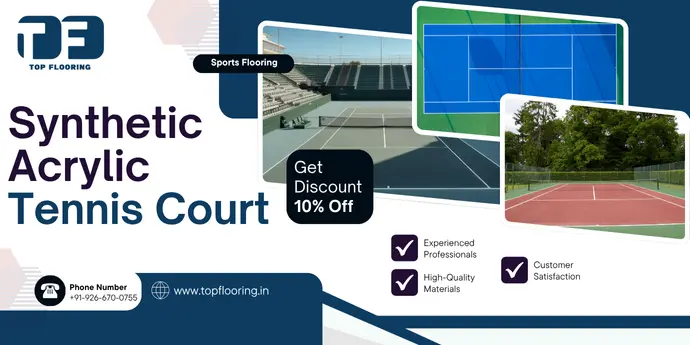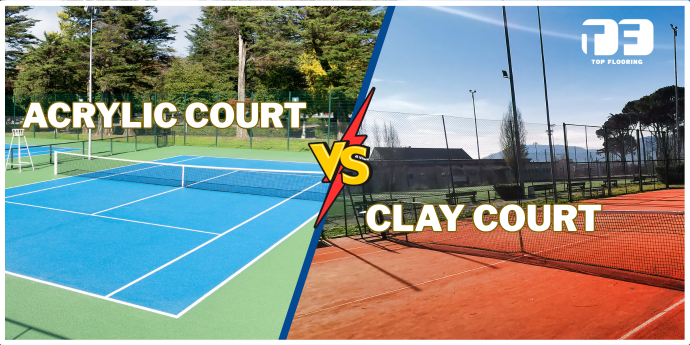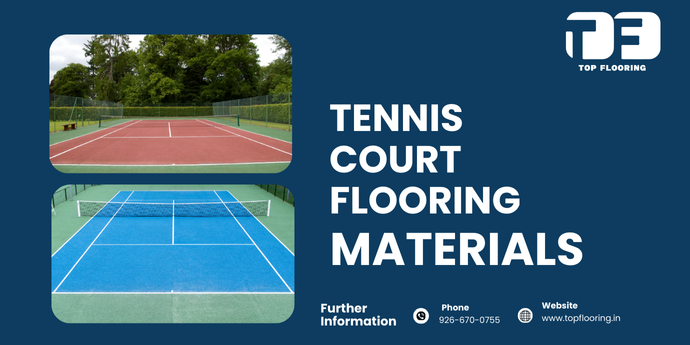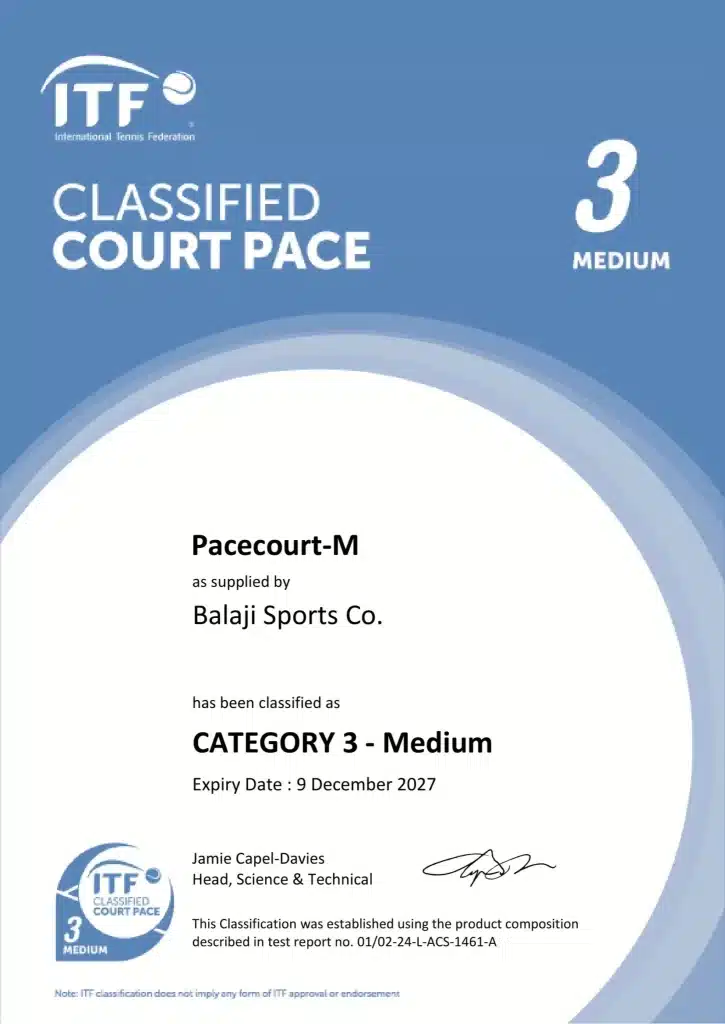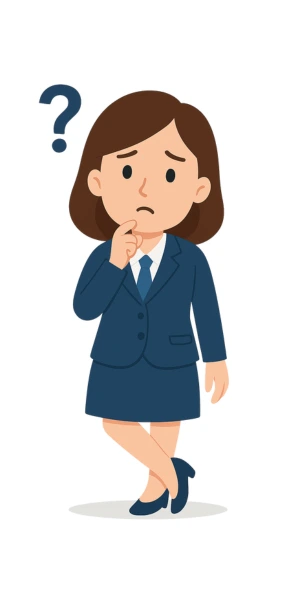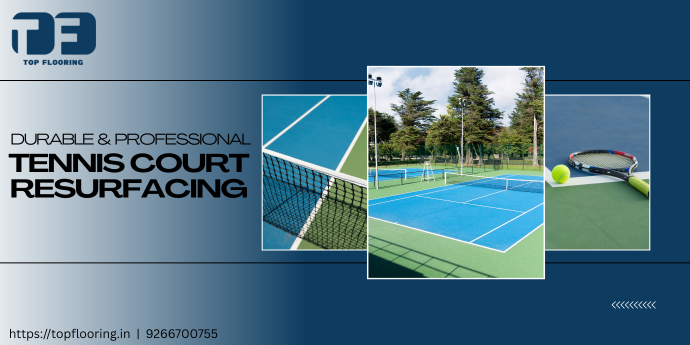
Every tennis court has a life. Even the best built tennis courts will show signs of wear and tear due to play, weather and natural aging. For schools, academies, clubs and even private facilities this raises an important question. should the court be rebuilt or can it be revived? This is where tennis court resurfacing comes in. Unlike full reconstruction, resurfacing restores the top layers of the tennis court flooring, fixes visible damage and strengthens the performance without disturbing the base structure. It’s faster, more affordable and highly effective when done with professional synthetic acrylic resurfacing materials.
This guide will cover everything you need to know what resurfacing is. Why it matters, how it’s done, the cost in India and why synthetic acrylic systems are the gold standard.
What is Tennis Court Resurfacing?
Tennis court resurfacing is the process of fixing and refreshing the top surface of an existing tennis court to get it back to its performance, safety and appearance. Over time tennis courts surfaces get worn out from constant play, sun, rain and temperature changes. These factors cause cracks, fading and uneven bounce making the court ugly and unsafe. Instead of going for a full rebuild which is expensive and time consuming. Resurfacing is the practical solution by addressing surface level issues while leaving the whole base. The process involves thorough cleaning, crack repair, resurfacer application, cushion coating for added comfort, fresh color coats and ITF standard line markings. In the end result is a brand new looking tennis court that not only looks new. But also performs at its best, with consistent ball bounce, better grip and improved player experience.
Why Resurfacing is Important for Tennis Courts?
- Playability: The most important reason to resurface a tennis court is playability. As courts start getting old, they lose their bounce stability and the ball reacts unconsciously. This is frustrating for players at all levels, beginners or pros. A perfect resurfaced tennis court gives even bounce and speed so the surface behaves as expected.
- Player safety: This is another big concern: Cracks, depressions and slippery patches not only disturb play but also increase the risk of slips, falls and long term joint injuries. Resurfacing removes these dangers by giving a smooth, slip resistant tennis court surface where players can move with confidence.
- Weather protection: Then comes weather protection, especially in India where extreme UV rays, heavy rains and heat changes take a charge on outdoor tennis courts. Without resurfacing these natural elements ruin the surface and cause cracks and color fading. Acrylic coatings provide a strong shield and protect the tennis court from harsh weather while keeping its looks.
- Cost effective: From a financial view resurfacing is cost effective. Building a new tennis court is a huge investment. But resurfacing gives a fresh high performance surface at a low of the cost. This is a smart option for schools, clubs and housing societies who want to maintain their facilities without overspending.
- Extends the life of the court: Finally resurfacing extends the life of the tennis court. With timely resurfacing every few years a tennis court can perform well for years. This long term approach makes sure facility owners get maximum value from their investment.
What is the Right Time to Resurface Your Tennis Court?
A tennis court doesn’t fail overnight. It shows signs slowly and being able to identify them early can save your money and safety risks.
Cracks across the court surface: The first sign is cracks across the tennis court surface. They start small but grow due to water logging and temperature changes. If this is left untreated they compromise the structure of the tennis court.
Standing water or drainage issues: Another obvious reason is standing water or drainage issues. After rain if water remains on the tennis court surface it means the slope or evenness of the tennis court has been affected. Water collection damages the surface further and makes it unsafe to play.
Fading and peeling paint: These are also signs the protective layers have faded off. This happens due to constant UV exposure which weakens the acrylic tennis court coating. Once the coating fades the surface becomes more open to cracks and slipperiness.
Slippery or dusty patches: These develop as the surface texture wears down. This reduces grip and makes it hard to move confidently, increasing the risk of injury.
Uneven bounce or dead spots: Lastly if players experience uneven bounce or dead spots it means the tennis court surface has lost its durability. This affects game quality and frustrates players especially during training or competition.
Ignoring these signs not only makes the tennis court unsafe but also increases long-term tennis court repair costs.
The Tennis Court Resurfacing Process
Resurfacing requires clarity, quality products and professional application. At Top Flooring, we do it to last and ITF approved.
1. Court Inspection & Cleaning: Every job starts with an inspection. This identifies structural issues, drainage problems and damage severity. Once done with inspection the tennis court is cleaned with high pressure water to remove dirt, moss and old debris.
2. Crack Repair & Base Patching: Special crack fillers and fiber mesh are used to repair tennis court surface cracks. If there are depressions or damaged areas, acrylic patch binders are applied. This makes sure a smooth base for the new tennis court surface layers.
3. Resurfacer Application: A base coat of acrylic resurfacer is applied to the whole tennis court. This smooths out rough patches and prepares the surface for further coatings.
4. Cushion Coat (Optional): For cushioned courts multiple layers of acrylic cushion coat are applied. These coats provide shock absorption, reduce stress on joints and improve player comfort ideal for academies and competitive facilities.
5. Color Coating: Durable, UV resistant acrylic color coats are applied in 2 or more layers. Popular choices are US Open style blue and green or the classic red and green.
6. Line Marking: Finally ITF approved white line markings are painted. This is done with precision to ITF standards.
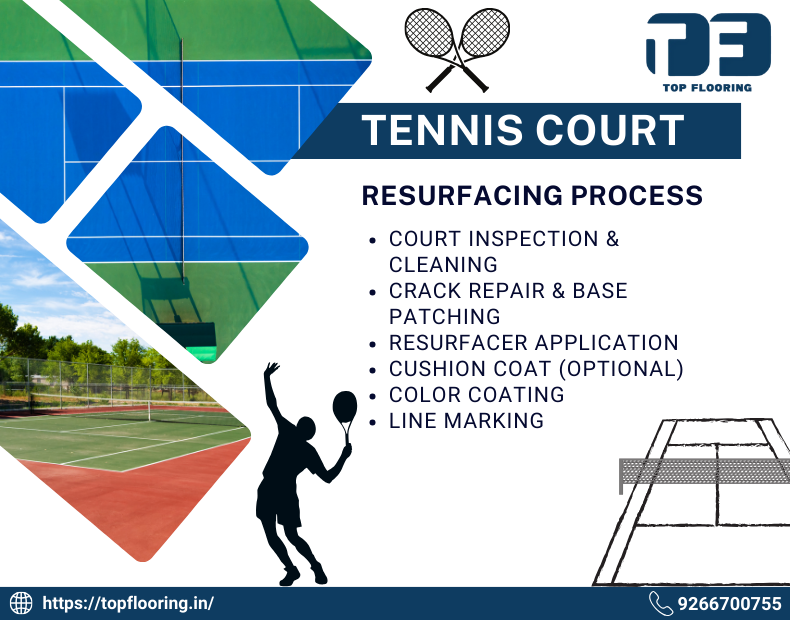
Why Choose Top Flooring For Tennis Court Resurfacing?
Choosing the right partner for tennis court resurfacing makes all the difference between a court that lasts a few seasons and one that delivers pro-grade performance for years. Top Flooring is one of India’s leading suppliers of synthetic acrylic resurfacing materials trusted by schools, academies, clubs and housing societies across the country.
- ITF-Certified Quality – Our resurfacing systems meet international standards for consistent ball bounce, superior grip and durability for recreational and competitive play.
- Engineered for Indian Climate – Designed to withstand extreme UV, heavy rains and high humidity our materials deliver long term performance without fading or cracking.
- Complete Range of Solutions – From primers and resurfacers to cushion coats, color coatings and line marking paints we have everything you need for a seamless resurfacing project.
- Nationwide Trust – With a wide dealer and contractor network Top Flooring has been a trusted partner for sports infrastructure projects in various locations across India.
- Focus on Safety and Comfort – Our cushioned acrylic systems reduce player fatigue, protect joints and create a safer environment for players of all ages.
- Commitment to Value – We combine affordability with quality so facility owners get a long lasting surface without the recurring expenses of cheap short term solutions.
When you choose Top Flooring you’re not just buying materials you’re buying a surface that supports better training, safer play and stronger sports communities.
Tennis Court Resurfacing Cost in India
The cost of tennis court resurfacing in India depends on many factors like the condition of the existing surface, type of acrylic system chosen and whether standard or cushioned coating is applied. Tennis Courts with minimal cracks and wear can be resurfaced at a lower cost. While those with larger patching, drainage improvement or additional cushion layers will cost more. Material also plays a big role- Basic acrylic systems are cheaper, advanced cushioned systems are more comfortable and durable but cost more.
Design preference is also a cost factor; some facilities opt for premium color combinations and finishes that look good. Although resurfacing requires an investment. It’s still way cheaper than reconstruction and gives long term value by extending the life of the tennis court and restoring professional level performance. For schools, academies, clubs and housing societies tennis court resurfacing is the most practical way to maintain a safe, good looking and playable tennis surface without having to rebuild the entire court.
Resurfacing vs. Rebuilding: What’s the Difference?
- Resurfacing – When the base is good. Fixes tennis court surface damage like cracks, fading and worn coatings. Faster, cheaper and extends life by several years without full reconstruction.
- Rebuilding – When the base slab has severe structural issues like deep foundation cracks, poor drainage or instability. Resurfacing won’t fix it and rebuilding from the ground up is the only way to get safety and performance back.
- Best Option in Most Cases – Unless the court is severely compromised at the base, resurfacing is the smarter, more practical choice for facility owners.
Benefits of Acrylic Resurfacing Materials
- Durability & Playability – Acrylic is the global standard for tennis courts as it gives long lasting strength and professional level performance.
- Consistent Ball Bounce – Players at all levels enjoy predictable and true ball response which makes the overall game better.
- Slip Resistant Surface – Textured finish reduces the risk of slips and falls making it safer for high traffic facilities like academies and clubs.
- Weather & Climate Resistance – In India’s harsh conditions of UV radiation, heavy rainfall and high humidity acrylic coatings stand strong against fading, cracking and water damage.
- Design Flexibility – Available in multiple colour options acrylic tennis court allows facilities to create visually appealing tennis courts in classic red-green or modern blue-green.
- Low Maintenance – Acrylic tennis courts are easy to clean, require minimal upkeep and last several years before another resurfacing is needed.
- Preferred Choice Across India – Because of these benefits acrylic resurfacing is trusted by schools, academies, clubs and housing societies all over India.
How Often Should You Resurface a Tennis Court?
It depends on how often the tennis court is used, the climate and how well it’s maintained. Most tennis courts need resurfacing every 5-7 years. Courts in high traffic areas like academies, clubs or public facilities may need resurfacing sooner, every 3-5 years, due to the wear and tear from constant play. Private residential courts with limited use can go longer before resurfacing is needed. In areas with harsh sunlight, heavy rainfall or poor drainage, resurfacing may be needed more often. The key measure is performance: if players notice uneven bounce, slippery patches or visible cracks, it’s time to resurface. By resurfacing on time, facilities can avoid major repairs, protect players from injuries and keep their tennis courts looking professional.
Maintenance Tips After Tennis Court Resurfacing
Resurfacing gives a tennis court a new life. But proper maintenance is key to make the investment last as long as possible. Regular cleaning is a must – Dust, dirt and organic growth like moss or algae should be removed with water and soft brushes to preserve surface texture and grip. Check for standing water after rains as improper drainage can rush surface damage. Use the tennis court only for its planned purpose, heavy vehicles, sharp equipment or footwear not designed for play should be avoided to stop unnecessary wear. Annual inspections by professionals can help identify early stage cracks or patches that can be repaired before they become big damage. Applying protective coatings at recommended intervals can also extend the life of the tennis court. With proper maintenance a resurfaced tennis court can last many years before another resurfacing is needed.
Tennis Court Resurfacing in India: Market Trends
The demand for resurfacing is increasing as the sports foundation grows in India. Here are the reasons why.
- Government advantage: Khelo India has encouraged schools and academies to upgrade their facilities, so more tennis courts are being resurfaced.
- Private academies: They are booming as tennis is becoming a popular sport among young athletes.
- Urban housing societies: Many urban housing societies now have tennis courts as part of their services, which need to be resurfaced regularly to be safe and look good.
- Cost conscious: Facility managers are becoming more cost conscious. They know resurfacing is better value in the long run than rebuilding. So they can maintain high standards without breaking the bank.
All these trends mean tennis court resurfacing will continue to be a growing segment in India’s sports flooring market.
Conclusion
Tennis court resurfacing goes beyond looks. It’s essential for safe, high performance courts that players can trust. By resurfacing on time, facilities protect players from injuries and ensure the game remains enjoyable with consistent bounce, grip and speed. Compared to the huge costs and downtime of complete reconstruction, resurfacing is the smarter, more sustainable option.
Another reason resurfacing has long term value is that it allows courts to evolve with modern standards. Many academies and sports clubs today demand cushioned acrylic systems that prioritize comfort, reduce joint strain and extend playtime for athletes. Resurfacing lets you upgrade an existing surface to a cushioned one, giving players a pro grade experience without having to start from scratch. For housing societies and schools, resurfacing also enhances aesthetics, turning old, faded courts into new, modern playfields that reflect pride and quality. As India strengthens its sports infrastructure under Khelo India and tennis grows among youth, the demand for durable, cost effective surfaces will only increase.
Frequently Asked Questions
Tennis court resurfacing at Top Flooring is the process of re-newing the top layers of the court to make it playable and safe. It includes cleaning, repairing cracks, applying acrylic resurfacer, adding cushioned or color coats and re-marking lines.
A resurfaced tennis court lasts 5 to 8 years before another resurfacing is required. Lifespan depends on climate, usage and maintenance.
The resurfacing process takes 2 to 4 weeks, depending on the extent of repairs, weather and whether a cushion system is added.
Acrylic resurfacer at Top Flooring is a specialized base coat used during tennis court resurfacing. It is applied after cracks and patches are repaired to create a smooth layer.
Tennis courts are resurfaced with acrylic resurfacing products like:
1. Crack fillers and patch binders for repairs.
2. Acrylic resurfacer for a uniform base.
3. Cushion coats for comfort (optional).
4. Acrylic color coats for durability and looks.
5. ITF-approved line marking paints for professional play.

